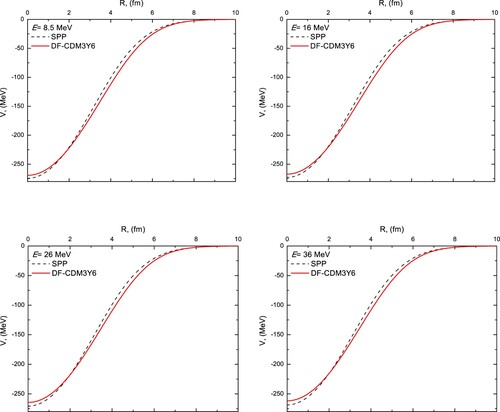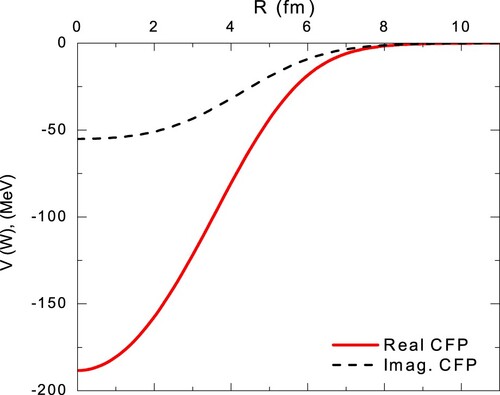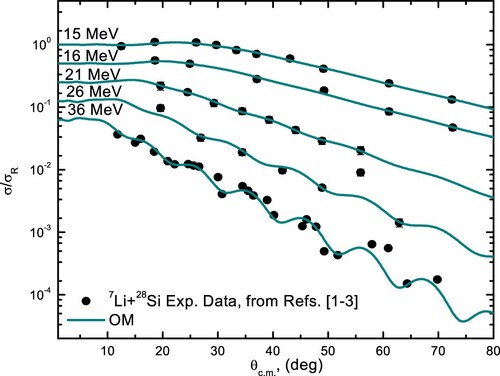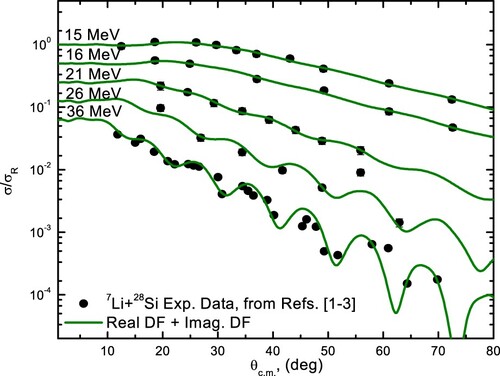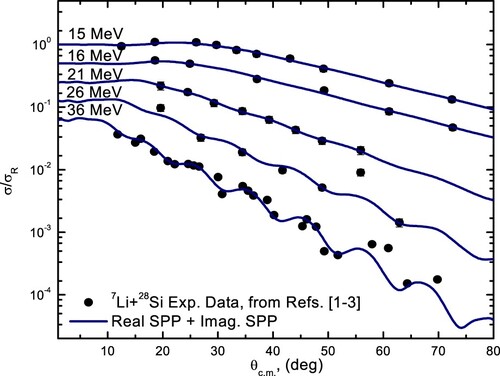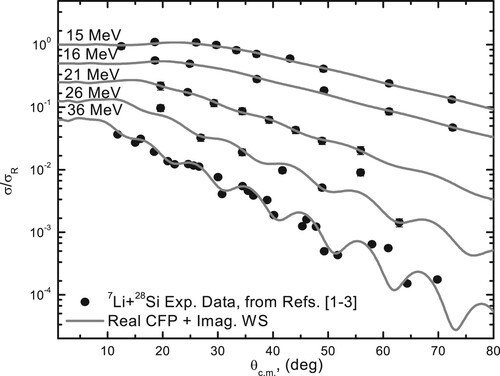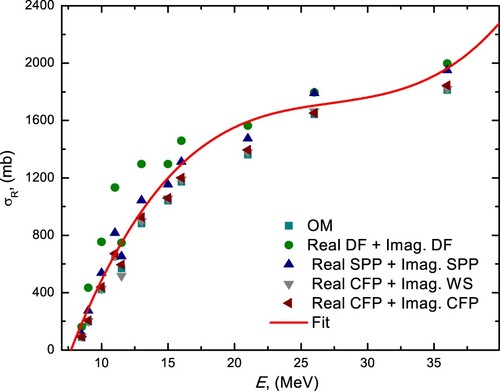 ?Mathematical formulae have been encoded as MathML and are displayed in this HTML version using MathJax in order to improve their display. Uncheck the box to turn MathJax off. This feature requires Javascript. Click on a formula to zoom.
?Mathematical formulae have been encoded as MathML and are displayed in this HTML version using MathJax in order to improve their display. Uncheck the box to turn MathJax off. This feature requires Javascript. Click on a formula to zoom.Abstract
The 7Li + 28Si angular distributions for elastic scattering in the laboratory energy range of 8.5–36 MeV are reanalyzed using different approaches based on both phenomenological and microscopic potentials. Special attention is paid to the α + t cluster structure for 7Li, which appears at a threshold energy of 2.468 MeV. The performed analysis using the different implemented potentials showed that the breakup of 7Li in the field of 28Si plays a strong effect in forming the cross sections. Such an effect results in a significant reduction in the renormalization factors of the utilized potentials. A satisfactory description of the data is achieved using the different implemented approaches.
1. Introduction
Understanding the role of the breakup channel in reactions initiated by weakly bound unstable projectiles requires a deeper understanding of the breakup effects for stable particles. As a result, many recent studies have focused on the interaction mechanism for various systems initiated by weakly bound projectiles such as 6,7Li and 9,10,11Be. The typical threshold anomaly (TA) phenomenon, which is well represented by tightly bound nuclei as a result of the strong couplings to inelastic channels and also to the low-lying states in both the target and projectile, is characterized by rapid change in the real and imaginary potential depth with respect to energies close to the Coulomb barrier energy (EC), where the real part exhibits a localized peak near the EC associated through dispersion relations, while the imaginary depth increases by increasing energy till reaching a constant plateau. Due to strong couplings to breakup channels, the TA is absent for nuclear processes initiated by weakly bound projectiles, resulting in a repulsive contribution to the real potential.
Studying the mechanism of interaction of weakly bound projectiles with various targets below, near, and above the EC is of special interest. One of these nuclear systems, which is the topic of the current analysis, is the 7Li + 28Si system, which was the subject of several experimental as well as theoretical studies [Citation1–17] that aimed to probe the peculiarities of this system at energies below and comparable to the EC. At eight near-barrier energies, Pakou et al. [Citation1] measured the 7Li + 28Si elastic scattering angular distributions (ADs). The data was investigated utilizing the continuum discretized coupled channel (CDCC) method, and the double folding optical model (DFOM) with the BDM3Y1 interaction was used for generating the real potential. The mechanism of interaction of both 6Li and 7Li on 28Si, as well as on the heavier targets 138Ba and 208Pb, was studied in Ref. [Citation1]. It was found that both 6Li and 7Li scattered from 28Si exhibit the same trend; the imaginary potential depth decreases with decreasing energy approaching the barrier, which contradicts the behaviour of 6Li scattered from the heavier targets (138Ba and 208Pb), where the imaginary potential presents an increasing. The consistency in potential behaviour for 6Li and 7Li ions beam scattering on 28Si could be attributed to a more systematic behaviour of weakly bound nuclei scattering on lighter targets. The real part of the 6,7Li scattering potential remains nearly constant, with a very modest diminishing behaviour seen mostly in the Si and Ba data. In addition, the CDCC calculations revealed that while breakup is more critical for 6Li than for 7Li, it is still insufficient to explain the potential at the barrier.
The elastic scattering ADs for 6,7Li + 28Si in the energy interval Elab = 11.5–26 MeV were measured by M. Sinha et al. [Citation2]. The measured ADs were analyzed using optical potential (OP), with imaginary surface and volume potentials. Moreover, the CDCC calculations for 6,7Li + 28Si elastic scattering data were done using FRESCO code by considering only the breakup of the projectile. In Refs. [Citation3,Citation4], the elastic scattering ADs of 7Li nuclei on 28Si were measured at Elab = 20 and 36 MeV. The measured ADs were compared with optical model (OM) calculations and a good agreement was obtained. In Refs. [Citation5,Citation6], the 7Li + 28Si ADs at Elab = 45 and 48 MeV were measured and theoretically analyzed using real folded potential, which was shown to be renormalized to produce a reasonable agreement with the measured cross sections. In Refs. [Citation7,Citation8], the ADs for 7Li ions of energies 177.8 and 350 MeV scattered from 28Si target have been measured. The obtained ADs revealed diffractive oscillations at forward angles followed by exponential falloff at the larger angle. Zerva et al. [Citation9] studied the excitation functions for 7Li + 28Si quasielastic scattering at 150° and 170° at sub-and near-barrier energies, and computed the relevant barrier distributions. The data was investigated using OM with real double-folded (DF) potential derived using the BDM3Y1 effective interaction. The barrier distributions were also investigated using coupled reaction channel (CRC) and CDCC methods to explore the effects of breakup and transfer reactions.
Different theoretical studies [Citation10–17] investigated the 7Li + 28Si nuclear system. In Ref. [Citation10], the ADs for 6,7Li elastically scattered from 12C, 28Si, 40Ca, 90Zr, and 209Pb at E/Ap = 12.5-53 MeV/u were investigated utilizing real DF potential and an imaginary WS potential. While in Ref. [Citation11], the same authors implemented the S1Y effective nucleon-nucleon NN interaction through the coupled channels (CC) method to fit the considered data. In Ref. [Citation12], a phenomenological dynamical polarization potential (DPP) was introduced to compensate for the necessary reduction in potential strength reported from the analysis of 6,7Li + 28Si systems. In Ref. [Citation14], 7Li + 28Si elastic scattering AD at E = 350 MeV was investigated using the CDCC method, and a fair description of the data was obtained. In Ref. [Citation15], the available 7Li + 28Si ADs in the energy interval 7.5–32 MeV were investigated using the OM of Woods-Saxon (WS) shape utilizing SPI-GENOA code. W. Chen et al. [Citation17] recently employed a microscopic approach to study the OP for 7Li + nucleus systems without any free parameters. The 7Li microscopic OP was used to predict the ADs for 7Li scattered from different targets ranging from 27Al to 208Pb.
Finally, it is important to note that the current research expands on our earlier studies [Citation18–25] that looked at the peculiarities and the mechanism of interaction between weakly bound projectiles and various target nuclei at energies both below and above the EC. The article is organized as follows. The potentials employed in the computations are presented in Sec. II. The analysis and discussion of the data are presented in Section III. The summary is covered in Section IV.
2. Theoretical formalism
2.1. Optical model potential (OMP)
Within the framework of OM, the ADs for 7Li elastically scattered from 28Si at Elab = 8.5, 9, 10, 11, 13, 15, 16 MeV [Citation1], 11.5, 21, and 26 MeV [Citation2], 36 MeV [Citation3] are reanalyzed. The utilized central potential is made up of a nuclear part of real and imaginary volume terms, each having a WS shape as well as a Coulomb part. According to previous research on nuclear processes induced by 7Li -projectiles, the effect of spin orbit potential (VSO) is minor and can be ruled out. The implemented OM potential takes the form:
(1)
(1) The Coulomb potential
is due to a uniform sphere with a charge equal to that of the target nucleus and radius
.
2.2. Double folding using CDM3Y6 interaction and Sao Paulo potential
It is preferable to construct the interaction potential utilizing microscopic methods in order to eliminate the different ambiguities that are inherited within OM potentials. Hence, the 7Li + 28Si system is investigated from a semi-microscopic perspective by utilizing the DF models using both the CDM3Y6 interaction potential and the Sao Paulo potential (SPP). The interaction potential CDM3Y6 was folded into the 7Li and 28Si density distributions. The density distribution of 7Li was taken from Ref. [Citation26] and has the form:
(2)
(2) while,
= 0.1387,
= 0.0232, and
= 0.3341. The density distribution of 28Si was taken from Ref. [Citation27] and is expressed as:
(3)
(3) The DF potential was computed using the DFMSPH code [Citation28]. The real DF potential is prepared by folding the 7Li and 28Si densities with the nucleon-nucleon NN interaction potential in the CDM3Y6 form based on the M3Y-Paris potential:
(4)
(4)
The M3Y-Paris interaction is scaled by a density-dependent function F(ρ):
(5)
(5) where ρ is the nuclear matter (NM) density, s is the separation between two interacting nucleons, and
are the direct and exchange parts of the M3Y-Paris. The
has an exponential dependency [Citation29] and is expressed as:
(6)
(6) The implemented DF potential is the sum of direct and exchange folded potentials:
(7)
(7) Similarly, the Sao Paulo potential SPP is based on folding the projectile and target densities with NN interaction potential [Citation30–34] and is expressed as:
(8)
(8) where the density distributions of 7Li and 28Si nuclei are denoted by
and
, with V0 = −456 MeV. The nuclear densities for 7Li and 28Si are obtained from the Dirac-Hartree-Bogoliubov model [Citation35]. Figure shows the prepared DF-CDM3Y6 as well as SPP at Elab = 8.5, 16, 26, and 36 MeV. As shown from Figure , the constructed potentials using both CDM3Y6 and SPP are very close to each other.
2.3. Cluster folding model
We aim to describe the 7Li + 28Si elastic scattering ADs using both the cluster folding optical model (CFOM) as well as the cluster folding model (CFM), taking into account the considerable cluster structure of 7Li as α + t system. The real and imaginary components of the 7Li + 28Si potential are created using the cluster folding (CF) procedure within the CFM framework. We define the 7Li + 28Si potential in terms of α-particles and (triton) + 28Si potentials as follows:
(9)
(9)
(10)
(10) where the relative motion of α- particle and triton in the ground state of 7Li is described by the intercluster wave function
. The
,
,
, and
are the phenomenological real and imaginary potentials for α + 28Si and t + 28Si channels at energies Et ≈ 3/7ELi and Eα ≈ 4/7ELi taken from [Citation36, Citation37]. The bound state form factor for α + t represents a 2P3/2 state in a real WS potential identified by the parameters (RV = 1.83 f m, aV = 0.65 fm), and the depth is adjusted to reproduce the binding energy for the cluster (2.468 MeV). Hence, the optimal potentials for t + 28Si and α + 28Si at suitable energies are implemented to create the cluster folding potential (CFP) for the 7Li + 28Si system. With a maximum energy of 36 MeV, the needed potentials are V t + 28Si at Elab = 3/7 × 36 = 15.43 MeV and V α + 28Si at Elab = 4/7 × 36 = 20.57 MeV. The created real and imaginary CFPs are shown in Figure . The analysis within the CFOM is performed using the real 7Li + 28Si CFP generated as described in EquationEq. 9
(12)
(12) , in addition to an imaginary part that has the traditional WS shape.
3. Results and discussion
3.1. OM analysis
The considered 7Li + 28Si ADs in the energy range of 8.5–36 MeV [Citation1–3] are investigated, utilizing pure phenomenological optical potential as a first step. The implemented potential as shown in EquationEq. 1(1)
(1) consists of both Coulomb and nuclear potentials. The nuclear potential has two parts: the real volume part of the WS shape and identified by three parameters; potential depth (V0), radius parameter (rV) and diffuseness (aV) to simulate the effect of scattering, and an imaginary WS potential of depth (W0), radius parameter (rW) and diffuseness (aW) to simulate the effect of reduction in flux. For exploring the variation of V0 and W0 with energy, fixed radius and diffuseness parameters for the real and imaginary parts, rV, aV, rW and aW at the values of 1.286, 0.853, 1.739, and 0.809 fm were used in the OM computations. These parameters were taken in accordance with Cook’s study [Citation38] concerning the global potential for 6,7Li projectiles.
As shown in Figures and , the OM analysis agrees well with the considered data using the optimal extracted parameters presented in Table . The calculations are performed using the FRESCO code [Citation39] and the SFRESCO search code. The χ2 value at the various considered energies was calculated to justify the good quality of the fit.
Figure 3. Experimental 28Si(7Li,7Li)28Si elastic scattering ADs (solid circles) at Elab = 8.5, 9, 10, 11, 11.5, and 13 MeV versus the OM fits (solid curves). Data is displaced by a factor of 0.5.
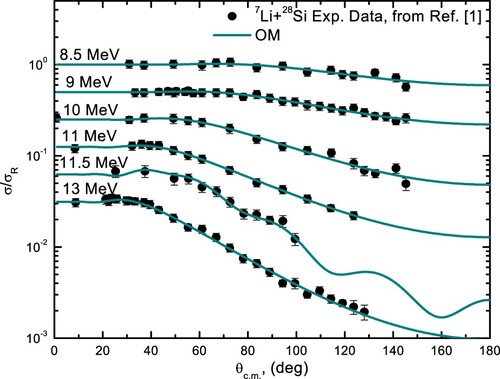
Table 1. Optimal potential parameters for the 7Li + 28Si system using the OM, (Real DF + Imag. DF), and (Real SPP + Imag. SPP) approaches. The OM calculations were performed using fixed geometrical parameters, rV = 1.286 fm, aV = 0.853, rW = 1.739, and aW = 0.809 fm. NRDF, NIDF, NRSPP, and NISPP are the renormalization factors for the real and imaginary parts of the potentials constructed based on the CDM3Y6 and SPP, respectively.
3.2. DF analysis using CDM3Y6 interaction and SPP
The elastic ADs for the 7Li + 28Si system are analysed using real DF potential generated based on the interaction model CDM3Y6, and the imaginary potential was considered as a factor times the real DF part. Thus, the implemented central potential is:
(11)
(11) Hence, two adjustable parameters, NRDF and NIDF, namely, real and imaginary renormalization factors, respectively, were implemented to fit the data. For simplicity, we shall call this approach (Real DF + Imag. DF). The comparisons between the experimental ADs and calculations within the framework of the (Real DF + Imag. DF) approach are reasonably good, as depicted in Figures and . The optimal NRDF and NIDF values obtained from the calculations using the aforementioned approach are presented in table . As shown in table , the average extracted NRDF value is 0.365 ± 0.098 which indicates the need to reduce the real folded potential strength by ∼ 63% to reasonably fit the considered data. The observed reduction in potential strength confirms the significant effect of 7Li breakup in the field of 28Si.
Figure 5. Experimental 28Si(7Li,7Li)28Si elastic scattering ADs (solid circles) at Elab = 8.5, 9, 10, 11, 11.5, and 13 MeV versus calculations using the (Real DF + Imag. DF) approach (solid curves). Data is displaced by a factor of 0.5.
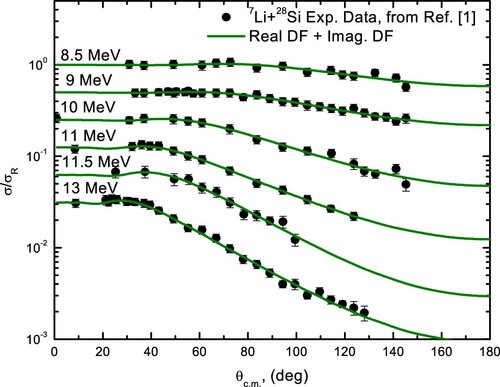
Another microscopic potential based mainly on the projectile and target densities as described in EquationEq. 8(11)
(11) is the microscopic SPP, which was implemented to fit the 7Li + 28Si ADs data. The imaginary potential was considered as a factor times the real SPP. Thus, the implemented central potential is:
(12)
(12) The data is reproduced utilizing two varying parameters, NRSPP and NISPP, namely, real and imaginary renormalization factors, respectively. For simplicity, we shall call this approach (Real SPP + Imag. SPP). The comparison between 7Li + 28Si ADs and the theoretical calculations utilizing the (Real SPP + Imag. SPP) approach is fairly good as depicted in Figures and using the potential parameters listed in table . The results revealed that to fairly fit the experimental data, the real SPP strength had to be reduced by ∼ 72%; the average extracted NRSPP value is 0.282 ± 0.097. The breakup effect of 7Li is mostly responsible for the observed decrease in potential strength.
3.3. Data analysis using CFOM and CFM
The considered data is reanalyzed utilizing the CFOM, which employs the real CFP generated by EquationEq. 9(12)
(12) in addition to an imaginary WS potential. The parameters of the imaginary WS potential obtained via the OM analysis are used without any adjustments in the CFOM calculations. As a result, the central potential is expressed as:
(13)
(13) Hence, one adjustable parameter NRCF, namely, the renormalization factor for the real CFP, was implemented to describe the data. For simplicity, we shall call this approach (Real CFP + Imag. WS). The agreement between the 7Li + 28Si ADs and the calculations utilizing the (Real CFP + Imag. WS) approach is reasonably good, as depicted in Figures and . Table shows the optimal potential parameters extracted from the CFOM analysis. The average extracted NRCF value is 0.445 ± 0.162 which emphasizes the need to decrease the real CFP strength by ∼ 55% to reproduce the experimental data.
Figure 9. Experimental 28Si(7Li,7Li)28Si elastic scattering ADs (solid circles) at Elab = 8.5, 9, 10, 11, 11.5, and 13 MeV versus calculations using the (Real CFP + Imag. WS) approach (solid curves). Data is displaced by a factor of 0.5.
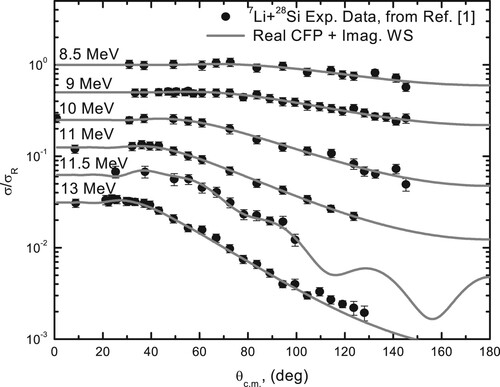
Table 2. Optimal potential parameters for the 7Li + 28Si system, obtained from the analysis using both CFOM and CFM. Within the CFOM, the imaginary WS potential parameters (W0, rW, aW) are kept fixed as those obtained from the OM calculations, and the data is fitted using one parameter, NRCF. Within the CFM, the data was fitted using two parameters, NRCF and NICF, which are the renormalization factors for the real and imaginary CFPs, respectively.
The full microscopic CFM is also tested to fit the data using both the real and imaginary CFPs that are displayed in Figure and described in Eqs. (9 and 10). Within the CFM, the central potential is:
(14)
(14) this approach is denoted as the (Real CFP + Imag. CFP). The concerned data is fitted utilizing two varying parameters, NRCF and NICF, which are the renormalization factors for real and imaginary CFPs, respectively. As illustrated in Figures and , the consistency between the experimental ADs and the calculated values using the (Real CFP + Imag. CFP) approach is reasonably good. Table gives the optimal potential parameters extracted from the CFM analysis. The average extracted NRCF value is 0.396 ± 0.143, indicating that the real CFP strength must be reduced by ∼ 60% to fit the experimental data reasonably.
Figure 11. Experimental 28Si(7Li,7Li)28Si elastic scattering ADs (solid circles) at Elab = 8.5, 9, 10, 11, 11.5, and 13 MeV versus calculations using the (Real CFP + Imag. CFP) approach (solid curves). Data is displaced by a factor of 0.5.
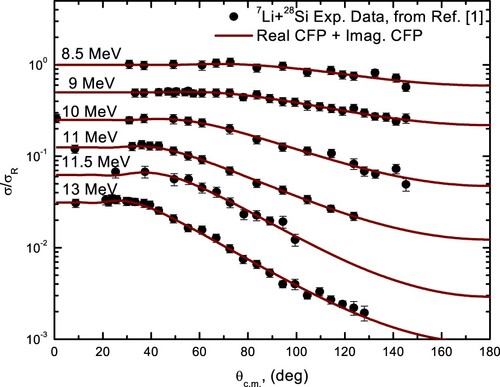
As the reaction cross sections (σR), real (JV) and imaginary (JW) volume integrals are important quantities that might be utilized to observe the existence or absence of the usual TA in 7Li + 28Si system. We are discussing the energy dependence on these quantities. The extracted JV and JW values from the performed analysis within the framework of the different utilized approaches showed that the so-called breakup threshold anomaly (BTA) [Citation40] is well presented in the 7Li + 28Si system, which agrees well with previous studies [Citation10–17]. As shown in Figure , the extracted JV and JW values do not obey the standard dispersion relation. The extracted JV and JW values from the different considered approaches are close to each other and exhibit the same trend which gives an evidence for the consistency of the adopted potentials. We also note that, while the various potentials show similar fits with data, as shown in Figures and the χ values listed in the tables are so close to each other, the presence of BTA can be further confirmed if experimental data are measured at backward angles and higher energies, where finer investigation on the considered potentials can be performed.
Figure 13. Energy dependence on the JV (a) and JW (b) values obtained from the different implemented approaches.

We have studied the energy dependence on the extracted σR values from the different implemented approaches as depicted in Figure , and it is found that they are nearly close to each other. This dependence shows that the σR values increase with increasing energy and can be approximated as: .
4. Summary
The 7Li + 28Si elastic scattering ADs at eleven data sets in the energy range 8.5–36 MeV are studied using different approaches utilizing various nuclear potentials. The analyzed data covers the energy range below, near and above the EC for 7Li + 28Si system. Therefore it is interesting to explore the mechanism of interaction as well as the different peculiarities that are presented in this energy range for 7Li + 28Si system. Five different approaches are implemented in data analysis as summarized below
Analysis using phenomenological OM potential of fixed radius parameters was successful in fitting the data, the obtained potential parameters showed the absence of the usual TA.
Within the frame work of the microscopic DF CDM3Y6 and Sao Paulo potentials, the considered data were analyzed. In both (Real DF + Imag. DF) and (Real SPP + Imag. SPP) approaches, the imaginary part was considered microscopically as a factor times the real folded potential. The analysis showed the need to reduce real potential strength by ∼ 63% and 72%, respectively.
Motivating by the well-observed α + t cluster structure for 7Li, the considered Data is investigated utilizing both CFOM and CFM. The analysis again confirmed the need to decrease the real CFP strength by ∼ 55% and 60%, respectively, to fairly reproduce the data.
The significant coupling effect to the breakup channel is responsible for the reported reduction in real potential strength created based on microscopic approaches such as DF and CFP.
Acknowledgement
This work was funded by the University of Jeddah, Jeddah, Saudi Arabia, under grant No. (UJ-21-DR-146). The authors, therefore, acknowledge with thanks the University of Jeddah technical and financial support.
Disclosure statement
No potential conflict of interest was reported by the author(s).
Additional information
Funding
References
- Pakou A, et al. Elastic scattering of 7 Li + 28 Si at near-barrier energies. Phys Rev C. 2004;69:054602.
- Sinha M, et al. Coupled channel effect in elastic scattering and fusion for 6,7Li+28Si. EPJ Web of Conferences. 2011;17:03004.
- Schumacher P, et al. Lithium elastic and inelastic scattering and lithium-induced single nucleon transfer reactions. Nucl Phys A. 1973;212:573.
- Bethge K, Fou CM, Zurmuhle RW. Elastic scattering of lithium nuclei. Nucl Phys A. 1969;123:521.
- Eck JS, et al. Optical model and coupled-channels analysis of 7Li + 28Si and 7Li + 40Ca scattering. Phys Rev C. 1982;25:2391.
- Madhusoodhanan T, et al. Study of α-transfer reaction 28Si( 7Li,t) 32S. J Phys G: Nucl Part Phys. 1999;25:1897.
- Lewitowicz M, et al. Elastic scattering of a secondary 11Li beam on 28Si at 29 MeV/nucleon. Nucl Phys A. 1993;562:301.
- Nadasen A, et al. Unique potentials for the elastic scattering of 350 MeV 7Li from 12C and 28Si. Phys Rev C. 1995;52:1894.
- Zerva K, et al. Probing the potential and reaction coupling effects of 6,7Li + 28Si at sub- and near-barrier energies with elastic backscattering. Phys Rev C. 2010;82:044607.
- El-Azab Farid M, Hassanain MA. Density-independent folding analysis of the Li elastic scattering at intermediate energies. Nucl Phys A. 2000;678:39.
- El-Azab Farid M, Hassanain MA. Folding model and coupled-channels analysis of 6,7 Li elastic and inelastic scattering. Eur Phys J A. 2004;19:231.
- Pakou A. Polarization potential for elastic scattering of 6 ,7 Li + 28Si at near-barrier energies. Phys Rev C. 2008;78:067601.
- El-Azab Farid M, et al. Alpha-deuteron (triton) analysis of 6(7)Li elastic scattering. J Phys G: Nucl Part Phys. 2013;40:075108.
- Pinilla EC, Descouvemont P. Microscopic description of 7Li in 7Li + 12C and 7Li + 28Si elastic scattering at high energies. Phys Rev C. 2014;89:054615.
- Kuterbekov KA, et al. Energy dependence of optical-model parameters for the interaction of 6Li and 7Li Ions with 28Si nuclei at low energies. Phys Atomic Nuclei. 2014;77:581.
- Furumoto T, Suhara T, Itagaki N. Effect of channel coupling on the elastic scattering of lithium isotopes. Phys Rev C. 2018;97:044602.
- Chen W-D, et al. Microscopic study of 7Li-nucleus potential *. Chinese Phys C. 2020;44:054109.
- Hamada S, Ibraheem AA. Peculiarities of 6Li+12C elastic scattering. Int J Mod Phys E. 2019;28:1950108.
- Hamada S, et al. Analysis of 6Li+16O elastic scattering using different potentials. Rev Mex Fis. 2020;66:322.
- Hamada S, Ibraheem AA. Cluster folding optical potential analysis for 6Li+28Si elastic scattering. Rev Mex Fis. 2021;67(2):276.
- Hamada S, Alsaif NAM, Ibraheem AA. Detailed analysis for 6Li+40 Ca elastic scattering using different potentials. Phys Scr. 2021;96:055306.
- Ibraheem AA, et al. Elastic and Inelastic Scattering of 9,10,11Be by 64Zn and 120Sn Nuclei at Different Energies. Braz J Phys. 2021;51:753.
- Ibraheem AA, Alsaif NAM, Al-Ahmari M, et al. Further investigation of 10,11B +58 Ni elastic scattering. Phys Scr. 2021;96:115307.
- Hamada S, Ibraheem AA. Comparative Analysis for 6Li + 58Ni System Within the Framework of Various Nuclear Potentials. Braz J Phys. 2022;52:29.
- Hamada S, Ibraheem AA. Anomaly in weakly bound 7Li nucleus in the field of 208Pb target. Int J Mod Phys E. 2022: 2250019.
- Vineyard MF, Cook J, Kemper KW, and M. N. Stephens. Optical potentials for the elastic scattering of 6Li + 12C , 6Li + 16O , and 7Li + 12C. Phys Rev C. 1984;30:916.
- Vineyard MF, Cook J, Kemper KW. Large-angle 6Li + 28Si elastic and inelastic scattering at 27 and 34 MeV. Nucl Phys A. 1983;405:429.
- Gontchar II, Chushnyakova MV. A C-code for the double folding interaction potential of two spherical nuclei. Comput Phys Commun. 2010;181:168.
- Dao T. Khoa G. R. Satchler, W. von Oertzen. Nuclear incompressibility and density dependent NN interactions in the folding model for nucleus-nucleus potentials. Phys Rev C. 1997;56:954.
- Allen LJ, McTavish JP, Kermode MW, et al. The root-mean-square radius of the deuteron. J Phys G. 1981;7:1367.
- Satchler GR, Love WG. Folding model potentials from realistic interactions for heavy-ion scattering. Phys Rep. 1979;55:183.
- Chamon LC, et al. Nonlocal Description of the Nucleus-Nucleus Interaction. Phys Rev Lett. 1997;79:5218.
- Chamon LC, Pereira D, Hussein MS. Parameterfree account of quasielastic scattering of stable and radioactive nuclei. Phys Rev C. 1998;58:576.
- Chamon LC. The São Paulo Potential. Nucl Phys A. 2007;787:198.
- Carlson BV, Hirata D. Dirac-Hartree-Bogoliubov approximation for finite nuclei. Phys Rev C. 2000;62:054310.
- Schwandt P, et al. Elastic scattering of polarized tritons from A = 26 − 28 nuclei at 17 MeV. Phys Rev C. 1982;26:369.
- Lega J, Macq PC. Angular momentum dependence in 22 MeV α-particle elastic scattering by light nuclei. Nucl Phys A. 1974;218:429.
- Cook J. Global optical-model potentials for the elastic scattering of 6, 7Li projectiles. Nucl Phys A. 1982;388:153.
- Thompson IJ. Coupled reaction channels calculations in nuclear physics. Comput Phys Rep. 1988;7:167.
- Hussein MS, Gomes PRS, Lubian J, et al. New manifestation of the dispersion relation: Breakup threshold anomaly. Phys Rev C. 2006;73:044610.

